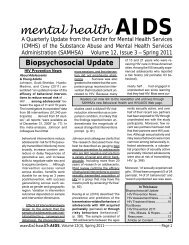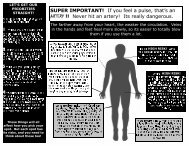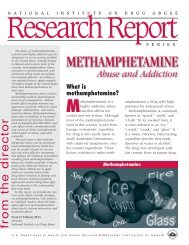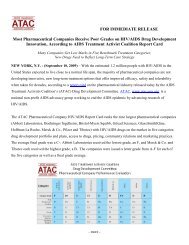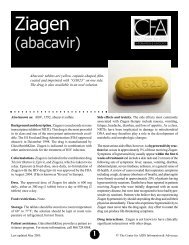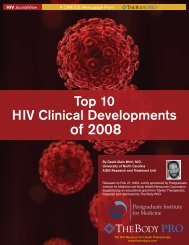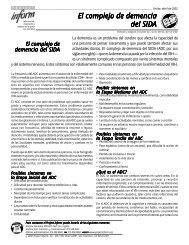here - CD8 T cells - The Body
here - CD8 T cells - The Body
here - CD8 T cells - The Body
You also want an ePaper? Increase the reach of your titles
YUMPU automatically turns print PDFs into web optimized ePapers that Google loves.
the mirror haS<br />
tWo faceS<br />
A personal account of using facial filler for lipoatrophy<br />
by Jeff berry<br />
eVER SIncE IT FIRST BEgan aPPEaRIng wITH<br />
some regularity in people with HIV in the mid 1990’s,<br />
lipoatrophy has earned its well deserved reputation<br />
as the Scarlet Letter of HIV, also known as “the look.”<br />
Lipoatrophy is the loss of subcutaneous fat under the skin, most<br />
notably in the face, but also in the butt, arms, and legs, and is<br />
thought to be part of a larger syndrome called lipodystrophy,<br />
which is the redistribution of fat in the body and can include buffalo<br />
hump, enlarged breasts, and visceral fat in the abdomen.<br />
It can sometimes be extremely disfiguring,<br />
and almost always causes some level<br />
of emotional distress, even depression,<br />
and oftentimes self-imposed isolation in<br />
those who suffer from its stigmatizing<br />
effects. It can also affect ad<strong>here</strong>nce to HIV<br />
medications, and deter people from starting<br />
treatment in the first place.<br />
<strong>The</strong> cause of lipoatrophy has been<br />
linked to certain HIV medications, most<br />
notably d4T (Zerit, stavudine) and to a lesser<br />
extent AZT (Retrovir, zidovudine) and<br />
ddI (Videx, didanosine); other HIV meds,<br />
including some protease inhibitors; and it<br />
has also been linked to HIV itself. D4T is<br />
rarely prescribed in the U.S. anymore, but is<br />
still widely used in many developing countries<br />
due to its availability and low cost.<br />
While we don’t see as many new cases of<br />
lipoatrophy <strong>here</strong> in the U.S. with those who<br />
have since initiated therapy using newer<br />
and less-toxic antiretrovirals, it is still prevalent<br />
among those using d4T in developing<br />
countries, although d4T continues to fall<br />
out of favor with providers and is used less<br />
and less as more and newer drugs become<br />
available in those regions.<br />
For those who have been treated with<br />
some of these older, more toxic drugs<br />
(when that was all that was available),<br />
many have developed the sunken cheeks,<br />
veiny arms and legs, and loss of fat in the<br />
butt to the point w<strong>here</strong> it is uncomfortable<br />
to sit for more than a short period of time.<br />
Once you discontinue taking a drug like<br />
d4T, you can sometimes stop the lipoatrophy<br />
from progressing any further, but it<br />
can take a long time to see any reversal of<br />
its effects, if ever, so some people will turn<br />
to using facial fillers to replace the fat in<br />
the face that has been lost.<br />
I have written several articles in the<br />
past, for both PoSITIVELY awaRE and<br />
<strong>The</strong><strong>Body</strong>.com, about my experiences<br />
dealing with the physical and emotional<br />
aspects of having lipoatrophy and its<br />
stigmatizing effects, as well as my experience<br />
using a facial filler, Sculptra (known<br />
then as New-Fill) back in 2001. <strong>The</strong> results<br />
I saw in 2001 were only moderate, and<br />
disappeared within about six months to<br />
a year, mainly due to the fact that I only<br />
received two treatments because that was<br />
all that I could afford.<br />
In THE FaLL oF LaST YEaR, I<br />
decided to revisit the idea of receiving<br />
another round of facial filler<br />
treatments, and I went to see Dr. Dan<br />
Berger of Northstar Medical Center in<br />
Chicago for a consultation. Dr. Berger, who<br />
also writes for PoSITIVELY awaRE, and<br />
has over 12 years of experience providing<br />
Sculptra, recommended that I undergo<br />
five or six “sessions” due to the level of<br />
facial lipoatrophy that I had. Facial lipoatrophy<br />
is graded on a scale of 1 to 5, with 1<br />
being mild, and 5 being severe—mine was<br />
severe, between grade 4 and 5. During<br />
each session, I was to receive injections of<br />
two vials, or one “kit” of Sculptra, one vial<br />
for each side of my face.<br />
Sculptra, or injectable poly-L-lactic<br />
acid, is one of only two FDA approved<br />
treatments in the U.S. for HIV-associated<br />
facial lipoatrophy, the other being<br />
Radiesse. Both of these injectables work<br />
by being absorbed into the body and<br />
stimulating the growth of the body’s own<br />
collagen, so they are not permanent fillers.<br />
T<strong>here</strong> are other fillers available (see<br />
table, page 43) that are also used for<br />
POSiTivElyAwARE.COM SEPTEMBER+OCTOBER 2012 41






